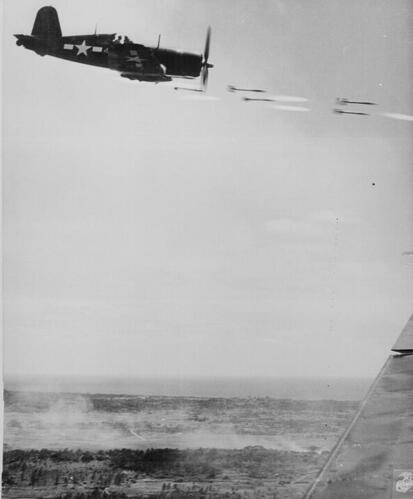As quoted above from Bergerud’s Fire in the Sky –
“By the time the Hellcat appeared, most of the Japanese pilots who could maximize the Zero had been killed in action”
And most of them by F4F Wildcat drivers. One could reasonably argue that the USN and USMC F4F pilots were largely responsible for the elimination of the cream of the IJAF in the air, from Coral Sea through the Guadalcanal Campaign. There were USN F4F squadrons flying in combat in the Solomons through July 1943, five months after the first USMC F4U squadron, VMF-124, entered combat on 11 February 1943.
“Hellcats fought fiercely on the large carrier raids made against Rabaul and neighboring fields in December 1943.”
Meanwhile, while participating in those raids, their carriers were CAPed by the F4U-1s of VF-17 flying up from New Georgia. They worked the morning CAP mission, landing aboard Essex and Bunker Hill without a single accident even after six weeks of land based only operations. They were refueled and re-armed while the pilots grabbed lunch, launched, and resumed CAP. Here they earned their pay, working over approaching Japanese counter strikes, claiming 18.5 kills before returning to New Georgia. Two Corsairs ditched en route home, both pilots rescued. This a year before F4Us appeared aboard carriers on a regular basis.
Kind of makes the question of what was the best naval fighter a little silly. Exactly by what measure does one want to define “best naval fighter”.
Biggest quality impact on an enemy?
That would be the F4F.
Biggest quantity impact on an enemy?
That’s the F6F.
Best overall aeronautic performance?
That’s the F4U for the planes actually entering combat, otherwise the nod goes to the F8F.
Best victory to loss ratio?
That’s the FM-2.
Best low speed maneuverability?
That’s the A6M.
So, by what criteria?
In which year?
Compared to what other plane developed when?
Is it fair to compare the F4U-4 with the A6M2 which were both flying combat at the same time?
What about night fighters? USN had F4U-2s, F6F-3N, F6F-3E, and F6F-5N operating off carrieres beginning in 1943 . . . what carrier based night fighter did the Japanese use?
And copping out with “best overall” doesn’t work because it still does not take into account the time periods; quality of adversary; frequency of, and opportunity for, combat; carrier based only vs carrier and/or land based.
Truth be known, having spent my younger years in the company of many of the folks most of us read about in the histories of USN aviation in the Pacific, any such discussion, and they were very rare, usually revolved around which particular airplane the speaker preferred fly over another and why. Combat had nothing to do with it. I knew one, an F4F ace, who preferred the handling of the F4F-3 over the F4F-4; thought the FM-2 was a very nice improvement on the F4F design overall; relished his time in A6M2s and A6M5s and flying the A6M2 against USN fighter pilots; thought the F6F to be a nice docile performer, very tough, and very forgiving; yet still claimed some of the sweetest rides ever were post war up and down the east coast in F4Us in the dark night between Anacostia NAS in DC and Cecil Field at Jacksonville during the B-36 hearings, even though he was skipper of the USN’s first operational jet squadron at the time.
Sorry to wax philosophical.
Rich

